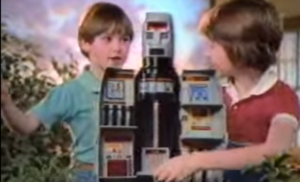Blame! by Tsutomu Nihei, first hitting the scene 20 years ago is getting a lot of attention these days with a new Master edition release from Vertical comics and a Netflix movie.
On the surface Blame! appears to be your stock-level dystopian, cyberpunk action-adventure, complete with hero that goes by the name Killy and his sidekick, Chiba. Looking closer though, you can see this is a story about a man and woman trying to overcome the oppression of the culture they were born into. Nihei chronicles this journey though beautiful illustrations of architecture and mechanical scenery, swaddled in transhumanism horror.
Killy, a Cyberpunk version of Blondie from The Good, Bad and The Ugly, fits as an avatar of what a Japanese male finds himself facing after college. In the real world it’s called shuukatsu, which is the hellish job-hunting process of newly minted college graduates. Instead of a job, Killy is hunting for something called the Net Terminal Gene. If he, and later Chiba when she joins him, can find it then they will have found a way to succeed in The City.
The City is an endless megastructure, separated by seemingly impenetrable barriers with leviathan sized levels in-between. One could argue this is Nihei’s way to illustrate the monolithic culture of Japanese corporations. To overcome these barriers, Killy uses the Graviton Beam Emitter, a crazy powerful gun about the size of a pistol. Think the Noisy Cricket from the MIB movies.
The Graviton Beam Emitter may even be an incarnation of Nihei’s talent for art. Like his creator, Killy uses this to climb or ascend to the next step in the endless ladder that is the City. Along the way the hero encounters obstacles to impede his quest. These take the form of everything from regular humans to horrific technorganic beings that may or may not be transhumans. These so-called “Silicon Life” bear the name Safeguards and operate in the same manner as real-world Japanese corporate bureaucrats. Like the bureaucrats, the Safeguards try to keep Killy in his place. However, he dispatches these creatures with his gun just as easily as he does with the barriers. Most of the time, anyway.
If there is a weakness to Blame! it is Nihei’s vague explanations of what is going on. There should be some sign posts, clearer info dumps when the pair get to a new level. There are little to no hints to what is going on except a mute badass blowing holes in roofs so he can climb upwards. At least that seems to be the case for most of the first volume of the series. Towards the end, things began to clear up a bit.
Nihei makes it all work – warts and all- though with his achingly detailed and surreal art. His architecture background shows through in the way he designs structures. The Silicone Life are Giger-esque and would fit in with a sci-fi Lovecraftian tale. Again, he doesn’t do as well with dialogue but his body language designs shore that up. Besides, Killy does a superb job of blowing things up in amazing fashion so no big loss. Chiba does this equally well but uses cyberspace and hacking in place of a gun.
Blame! hits all the right notes for a Cyberpunk/Transhumanism action story and if that is your jam, then you can’t go wrong by picking this up. If not, you still can’t beat it what with the gorgeous art and design. It’s a worthy addition to the likes of Blade Runner, Ghost in the Shell and Neuromancer.
